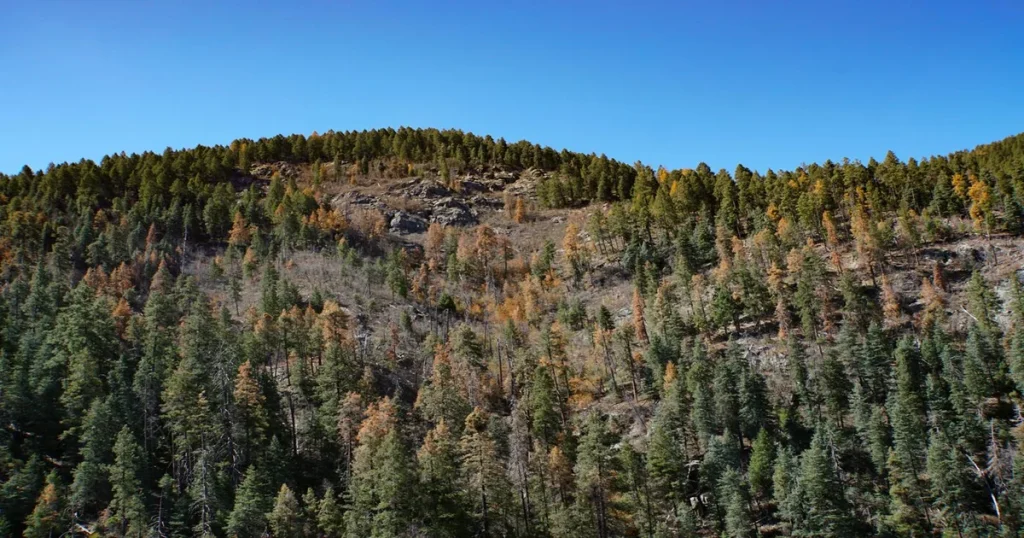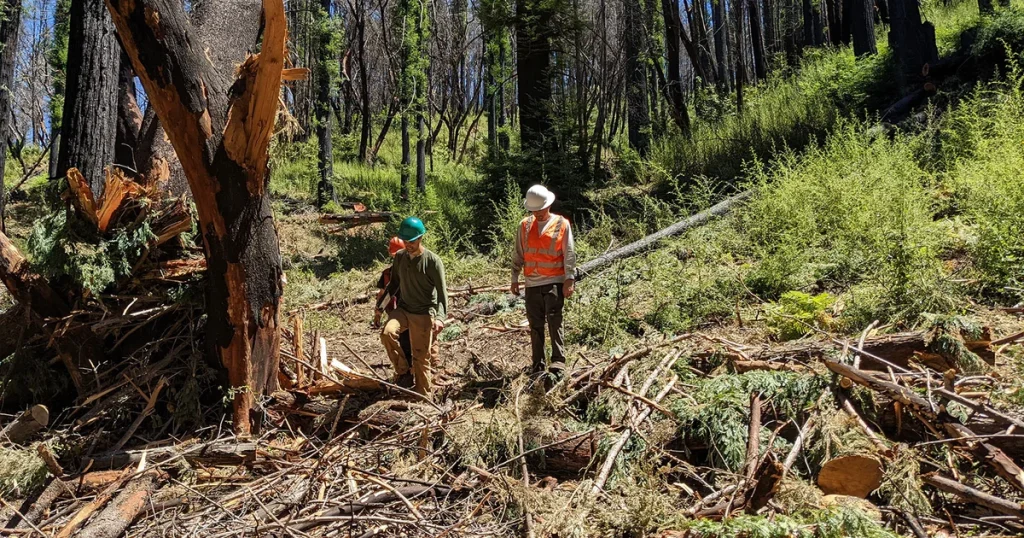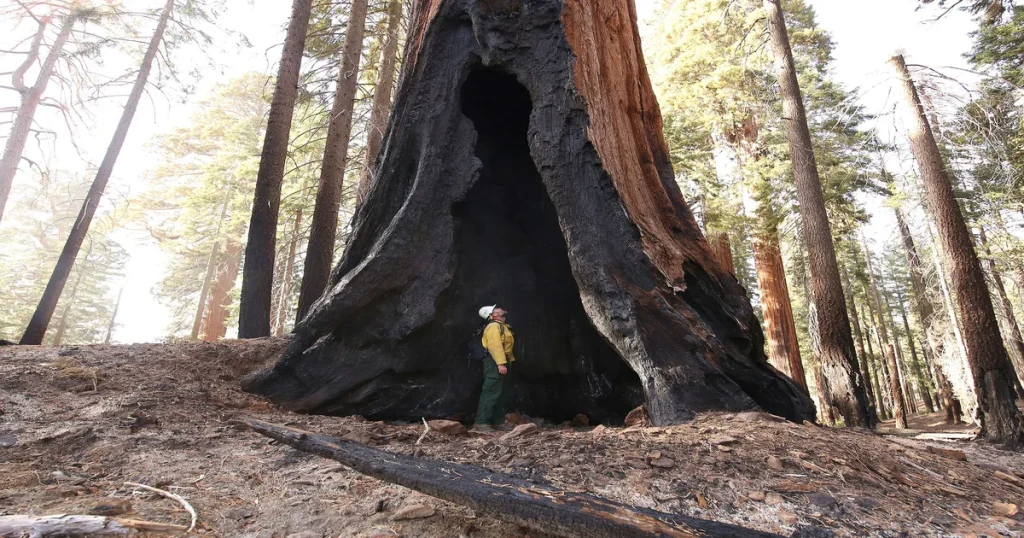Prescott National Forest, a natural gem spread over 1.25 million acres, has been a haven for nature enthusiasts for generations. Its vast expanse offers a plethora of scenic trails, where one can marvel at the ecosystem’s diversity. However, the serenity of these trails hides an alarming reality.

The impact of climate change on trails in Prescott National Forest is evident, reshaping the very character of this cherished woodland.
Historical Climate Data in Prescott National Forest
Historically, the Prescott National Forest has enjoyed a mild climate, marked by its four distinct seasons. This climatic rhythm has been a pivotal factor in shaping the forest’s ecology. Over the decades, records from the National Weather Service have shown consistent temperature and precipitation patterns.
However, recent years have seen a deviation from these patterns. Studies show an increasing trend in temperatures and erratic rainfall patterns. These changes are not isolated incidents but rather indicators of the larger issue at hand – the global climate crisis.
Physical Changes in the Forest
As temperatures rise, the forest is undergoing discernible physical alterations. One of the most striking changes is in the tree density. The once dense forest canopy is showing signs of thinning. Research reveals that prolonged drought conditions, a consequence of climate change, are impacting tree growth and survival.
Erosion is another alarming issue. With unpredictable rainfall, the soil lacks the time it needs to absorb water effectively. This leads to surface runoff, which in turn erodes trails and even leads to the formation of new, unintended pathways.
Hydrological Shifts
The water dynamics of Prescott are experiencing upheavals. Streams that once flowed year-round are now seasonal. In some places, once-bubbling springs are dwindling or have dried up altogether. Such shifts affect the entire ecosystem and the trails that meander through them.
Trails that used to run alongside beautiful brooks now overlook dry riverbeds. Not only does this impact the scenic beauty, but it also affects the soil’s integrity, making trails less stable and more prone to erosion.
Flora: Struggling and Adapting
The plants of Prescott National Forest tell a tale of resilience and struggle. Native species like the Ponderosa Pine are showing stress signs, with some trees even succumbing to the changing conditions. Simultaneously, species not native to the region are finding the altered climate conducive and are gradually making an appearance.
• Alteration in blooming seasons. • Appearance of non-native species. • Native plants under stress.
The resultant change in flora inevitably impacts the trail experience. Once shaded paths may now be sunnier and vice versa. Moreover, invasive species can alter the soil quality, affecting the very foundation of the trails.
Fauna: Movement and Adaptations
Climate change is pushing many animal species out of their comfort zones. Prescott’s native fauna, from small insects to larger mammals, are on the move, seeking more favorable conditions. This migration disrupts the food chain, which in turn affects the entire ecosystem.
On the other hand, invasive species are making Prescott their new home, altering the dynamics of the region. These new additions can impact the trails, either through burrowing or other activities that may erode or damage pathways.
Changing Trail Dynamics
With the ongoing environmental changes, trail dynamics are not left untouched. Some trails have become less accessible due to waterlogging or erosion, while others have become more open due to reduced tree cover. Trail management teams often need to reroute or redesign paths to ensure safety.
Such shifts can be jarring for regular visitors. Familiar landmarks may change or disappear, and the overall trail experience can feel vastly different from one year to the next.
Impacts on Recreational Activities
Prescott National Forest isn’t just a haven for hikers; it’s a hub for various recreational activities. From horseback riding to mountain biking, the trails serve multiple purposes. However, the changing trails mean that some activities are now more challenging.

For instance, trails that were once perfect for mountain biking may now have sections that are too eroded. Horseback riders might find that some paths are too unstable for a safe ride. As such, visitors need to be agile and adaptive, staying updated on trail conditions before planning their activities.
Economic Implications
Prescott National Forest is more than an ecological wonder; it’s an economic pillar for the region. Tourism, fueled by the forest’s allure, brings in significant revenue. However, with changing trail conditions and the potential decrease in wildlife sightings, there might be a dip in tourist numbers.
Moreover, maintaining and restoring trails in the face of climate change isn’t cheap. Funds allocated for regular upkeep now have to cover the additional costs of combating the impact of climate change. This can strain local economies that depend heavily on the forest’s appeal.
Mitigation Efforts and Conservation
Despite the challenges, hope is far from lost. Forest management, in tandem with local communities, is investing time and resources in mitigation efforts. From trail restoration to controlled burns aimed at rejuvenating the forest, multiple measures are underway.
Public involvement is crucial in these efforts. Local communities play a pivotal role, from participating in cleanup drives to educating visitors on responsible trail usage. Every hand that helps ensures that Prescott remains a treasure for generations to come.
Safety Concerns for Hikers
For those who love hiking the Prescott trails, safety has become a paramount concern. Changing trail conditions mean that paths that were once deemed easy might now pose challenges. Uneven terrain, weakened soil, and even sudden water surges in previously dry areas are all potential hazards.
It’s essential for hikers to stay updated about trail conditions. While forest management does its best to keep trails safe, nature can be unpredictable. As always, preparation is key. Carrying adequate supplies, informing someone of your route, and being equipped with a reliable GPS can make a world of difference.
The Bigger Picture: Forests and Climate Change
Prescott National Forest’s challenges mirror those faced by woodlands worldwide. Forests play a crucial role in regulating our planet’s climate, acting as carbon sinks and producing the oxygen we breathe. The health of forests like Prescott is indicative of our planet’s health.
Addressing the challenges in Prescott requires a holistic approach. While local efforts are pivotal, global actions to combat climate change are equally crucial. Only with a concerted effort can we hope to restore the balance and ensure that forests continue to thrive.
Looking Ahead: Predictions and Projections
Given the current trajectory, Prescott National Forest might undergo even more significant changes in the coming decades. While predictions can be daunting, they offer a roadmap for mitigation.
Projections suggest that temperatures in the region might continue to rise. This could further affect the hydrological systems, possibly leading to drier conditions. Such scenarios highlight the importance of preemptive action and adaptive strategies to safeguard the forest and its trails.

The Role of Education
Ignorance might be bliss, but when it comes to climate change, knowledge is power. Educating the masses about the ramifications of a changing climate is pivotal. It’s not just about informing but inspiring action.
Schools, community centers, and even digital platforms play a pivotal role in this educational journey. Workshops that focus on the intricacies of forest ecosystems, online campaigns highlighting the beauty of Prescott, and hands-on field trips for students can all contribute to a more informed populace.
It’s one thing to read about climate change; experiencing its effects first-hand leaves a lasting impression. By fostering a deep connection between individuals and the forest, the hope is to inspire proactive measures. The more people understand the significance of Prescott and its trails, the more inclined they’ll be to contribute to its preservation.
Harnessing Technology for Conservation
In the age of digital transformation, technology offers a lifeline for conservation. Tools like satellite imaging can monitor forest health in real time, identifying areas at risk before they become critical. Advanced GIS systems allow for better trail management, helping identify erosion, waterlogging, and other issues before they pose significant threats.
Digital surveillance, using drones and remote cameras, can keep an eye on wildlife movement. Such insights can aid in understanding how fauna is adapting and what measures can assist them.
Moreover, user-generated data, from apps and platforms where hikers share their experiences, can be a goldmine of information. These firsthand accounts offer invaluable insights into the trail’s current state and potential challenges.
Personal Stories: Interviews with Regular Trail-goers
For Sarah, a Prescott trail regular for the past decade, the transformation is evident. “Sections of the trail that once had me walking under a canopy of leaves now feel exposed. The sounds have changed too, fewer birds chirping,” she notes with a hint of melancholy.
Mike, an avid biker, feels the terrain shifts. “Some trails are trickier now, with patches eroded. It demands more attention, more care while biking.” It’s not just the physical changes but the ambiance too. The once predictable trails now hold elements of surprise, not always pleasant.
Such testimonials emphasize the human element, reminding us that behind every statistic, there’s a personal experience, a story of adaptation and nostalgia.
Case Studies: Other Forests Undergoing Change
Prescott isn’t alone in its battle against climate change. Forests globally are feeling the heat, quite literally. The Amazon rainforest, often dubbed the Earth’s lungs, has seen unprecedented wildfires in recent years. Studies suggest a direct correlation between rising temperatures and these fires.
Closer to home, the Great Smoky Mountains National Park has also been a victim of changing weather patterns. Erratic rainfall has led to similar trail erosions and shifts in flora and fauna. By looking at global instances, there’s an opportunity to learn, adapt, and even collaborate on conservation strategies.
Call to Action
The beauty and serenity of Prescott National Forest are treasures worth preserving. But it demands collective action. Here’s how one can make a difference:
- Educate and Advocate: Knowledge is the first step. Share what you know, encourage discussions, and raise awareness.
- Responsible Visitation: When using the trails, ensure you’re not leaving behind waste, and stick to designated paths.
- Support Local Initiatives: Many community groups are working towards conservation. Lend a hand, be it through donations or volunteering.

The forest gives us so much; it’s time to give back.
Frequently Asked Questions: Impact of climate change on trails in Prescott National Forest
What are the most noticeable changes on the trails?
Besides visible erosion and altered flora, changes in wildlife sightings and trail accessibility due to waterlogged or dried-up sections are prevalent.
How safe is it to hike in Prescott National Forest now?
While many trails remain safe, it’s essential to stay updated on trail conditions and prepare accordingly.
What is being done to conserve the forest and its trails?
Forest management, in collaboration with local communities, is implementing mitigation efforts like trail restoration and public education campaigns.
How can I help in preserving the beauty of Prescott’s trails?
Supporting local conservation initiatives, practicing responsible trail use, and spreading awareness are vital steps anyone can take.
Conclusion
Prescott National Forest, with its intricate web of trails, is a testament to nature’s grandeur. Yet, the very essence of this woodland is under threat from the looming shadow of climate change. As the trails evolve and the forest adapts, it’s a stark reminder of the delicate balance between man and nature.
While the challenges are real and multifaceted, with concerted efforts, there’s hope. Hope that future generations will meander through Prescott’s trails, reveling in its beauty, just as we do today.



Leave a Comment
You must be logged in to post a comment.